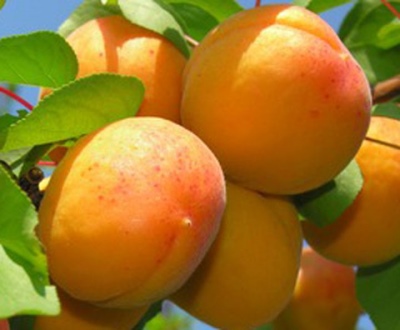
- Authors: domestic selection
- Appeared when crossing: Hardy x Shalah
- Fruit weight, g: 50-70
- Fruit shape: one-dimensional, oval
- Fruit color: light orange, with a slight tan on the sunny side
- Pulp color : light orange
- Pulp (consistency): medium, juicy
- Fruit taste: very sweet, excellent
- Tasting assessment: 4.8-5 points
- Bone size: small
Most gardeners appreciate the Delight apricot variety for its high yield. The fruits of a hybrid of domestic selection are eaten with pleasure, for which the variety got its name.
Breeding history
To get a new kind of apricot, the staff of the Nikitsky State Botanical Garden crossed the Voslivy and Shalakh varieties (Erevani). In 1989, the novelty was accepted for state testing. The variety is recommended for cultivation in the North Caucasus region. Synonyms for the name: Magic or Basil Caccio.
Description of the variety
An actively growing tree with a rounded, spreading crown of medium thickening. On slightly raised branches with dark green leaves, beautiful flowers first appear. They must be removed in the first year. It blooms in the early to mid-term. The variety is partially self-fertile. In the third decade of July, rather large light orange apricots grow on the branches.
Fruit characteristics
The fruits of Pleasure are large in size, weighing about 50-70 grams. They have a one-dimensional oval shape (ovoid), slightly flattened on the sides. The apex is slightly pointed and sloping towards the back, as if with a small "beak".
The color of the apricots is sunny orange, with a soft tan on the south side. In area, it takes up to 1⁄4. Sometimes the tan appears more brightly, almost to a raspberry hue and 1⁄2 of the surface of the fruit. The skin is velvety, with a light edging.
Inside there is a light orange pulp and a small bone. It has good separability from the pulp. The kernel tastes sweet. The attachment strength of the apricots is good.
Taste qualities
Experts give apricots 4.8-5 points on a five-point scale. They taste amazing - very sweet, but not sugary. Like a fresh natural dessert. The consistency of the pulp is medium in density, but juicy, melting on the tongue.
Ripening and fruiting
Fruits on the tree ripen 3-4 years after planting. This is considered a medium ripening period. The frequency of fruiting is annual.

Yield
The yield of the trees of this variety is high and regular. Gardeners manage to collect about 35-40 kg from one apricot.
Growing and caring
For the rooting of plants, a very important period in a new place is the first 21 days from the day of planting.
Timely and correct actions in the initial weeks after planting significantly affect the survival rate of seedlings and their development in the future.
- Cropping
This has a positive effect on all fruit plants. Apricot Pleasure responds to pruning by increasing the weight of the fruit. It is important to understand that in the first months without pruning and with irregular or insufficient watering, plants will significantly reduce the chances of rooting.
When planting, it is important to prune, reducing the length of the shoots to 45 cm. It is also recommended to remove dry and damaged shoots annually, thin out the crown and form it.
- Watering
Young crops require regular and adequate watering.The seedlings will successfully root, if not only to moisten the soil superficially (by 8-12 cm), but water it deeply, to the ends of the tree roots (up to 40-45 cm).
To do this, during the first month after the planting, it is necessary to water the crop twice a week. In this case, 1 bucket is consumed per each tree.
In dry season, watering should be doubled in volume of water and done 2-3 times a week. Irregular watering is considered a common mistake of inexperienced gardeners. This is one of the most important factors affecting the rooting of seedlings of fruit crops.
- Mulching
To keep moisture in the soil longer, it is worth organizing organic mulching in the area of the trunk circle. The mulch is distributed in a layer of 8-10 cm.
- Loosening
It is necessary to loosen the soil shallowly, removing all weeds in the near-trunk area.
- Landing dates
To make it easier for plants to take root in a permanent place, it is important to follow the steps in a specific sequence. First, there is a cold snap in the natural environment, then - the time of leaf fall and the transition of plants to the resting phase. It is at this stage that the transplant takes place, and only in this sequence. Winter hardiness of this variety is average.



Disease and pest resistance
The hybrid is very resistant to diseases and parasites. Experts note that problems at this level begin if the plant is deficient in minerals. For example, when gum leakage is detected, it can be said for sure that the apricot lacks calcium.

Review overview
In the reviews, gardeners note that the taste and texture of the apricot varieties are ideal for making dried fruits and aromatic jam. And also apricot Pleasure is suitable for filling in sweet pastries, compotes, as well as alcoholic beverages. In particular, its fermented juice serves as raw material for the preparation of apricot vodka. They say that the keeping quality of fruits is high. The same can be said about their transportability and marketability.































































